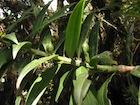
Burned specimen of Podocarpus rusbyi beside a strawberry-field,
Province Manuel María Caballero, Bolivia [Burkhard Witt].

"Pino amarillo" with its characteristic new yellow shoots,
Province Manuel María Caballero, Bolivia [Burkhard Witt].

Young seed cones, Province Nor Yungas, Bolivia [Burkhard Witt].

Triangular bud scales with long sharp tips, Province Nor Yungas, Bolivia [Burkhard Witt].

Conservation Status

Podocarpus rusbyi
J.T. Buchholz & N.E. Gray 1948 (p. 134)
Common names
Pino amarillo, pino blanco, chonga pino, pino del monte. It is called "pino amarillo" for the yellow color of new shoots (Vargas et al. 2000).
Taxonomic notes
Type collection Bolivia: La Paz, H.H. Rusby 2463. Its general systematics within Podocarpus have not been examined, but it is likely closely related to the other South American species.
Description
Trees to 25 m tall and 60 cm DBH, typically forming a broad open crown, but more bushy at high altitudes. Bark brown, aging to gray, becoming fissured and scaly with age. Twigs stout, 5-7 mm wide at base, round, grooved between leaf bases, ending in broad conical buds with lanceolate-acuminate outer scales 5-10 mm long and spreading, with smaller, converging inner scales. Juvenile and shade leaves 4-9 cm × 6-10 mm; mature and sun leaves 3-5 cm × 5-8 mm; elliptic to linear-lanceolate, widest near middle, base short-petiolate, margins slightly revolute, apex acute, coriaceous, deep green above, pale green below, with midrib a continuous narrow groove on upper surface and raised, narrow, continuous to apex on lower side. Stomata on lower sides of leaves in numerous intermittent lines. Seed cones axillary, solitary, on 3-10 mm long peduncles, receptacles fused and swollen to 6-8 mm long, green maturing red, with exserted triangular bract tips. Seeds single, ovoid-globose, 7 mm long including epimatium, dark green (Farjon 2010).
Distribution and Ecology
Bolivia: Cochabamba, La Paz, and Santa Cruz; and Peru: Cuzco and Machu Pichu; in tropical montane rainforest and high montane cloud forest at elevations of 700-3350 m, up to timberline. Occurrences in Peru are limited to the Cuzco area in lower montane rainforest at 700-1300 m elevation, and near Machu Pichu in high montane forest at 2900 m elevation. Most of the species' distribution is in Bolivia, at 1500-3350 m elevation. The habitats and elevational distributions are similar to those of Podocarpus parlatorei, but the two species are geographically separate (Farjon 2010). "At high altitudes it forms thickets with other dwarfed trees and shrubs. In Parque Nacional Madidi it is associated with Weinmannia fagaroides, W. microphylla, W. bangii, Clusia spp., Myrsine coriacea, Psychotria tristis, Miconia spp., Persea spp. Ternstroemia spp., Freziera spp., and Symplocos spp." (Gardner 2013).
Although the species is fairly widely distributed (area of occurrence more than 22,000 km2), forest clearing for agriculture (mainly coca production) has produced a severe and continuing loss of habitat, with habitat fragmentation. Only 10 remaining occurrences are documented, with an area of occupancy of not more than 2000 km2; thus it is classified as "vulnerable". In Bolivia this clearing is even occurring in National Parks. Habitat loss is also proceeding both directly and indirectly as a result of intensified road-building (Gardner 2013; assessment 2011).
Burkhard Witt (email 2019.08.15) reports that "Between 2010 and 2018 in Province Manuel María Caballero I found many patches inside cloud forests converted into
strawberry-fields. On the other hand, in contrast to most other Bolivian Podocarpus
species, P. rusbyi in Province Manuel María Caballero shows good regeneration in opened forests where grazing is not too heavy. A situation comparable to P. parlatorei."
Remarkable Specimens
Ethnobotany
Observations
P. rusbyi has been collected, and is protected, within Machu Pichu National Park in Peru; this might be the easiest place to find it. A collection is recorded at 13.15°S, 72.517° W, which appears (2019 photography) to be dense forest. The Conifers of the World site provides additional location information.
Remarks
The epithet remembers the first collector, botanist Henry Hurd Rusby (1855-1940) (Farjon 2010).
Citations
Gardner, M. 2013. Podocarpus rusbyi. The IUCN Red List of Threatened Species 2013: e.T34097A2845472. http://dx.doi.org/10.2305/IUCN.UK.2013-1.RLTS.T34097A2845472.en, accessed 2019.09.25.
Vargas, Israel G., Anna Lawrence, and Miguel Eid Otazu. 2000. Árboles y
arbustos para sistemas agroforestales en los Valles Interandinos de
Santa Cruz, Bolivia. Santa Cruz de la Sierra, Bolivia: Editorial Fundación Amigos de la Naturaleza Noel Kempff: Centro de Investigación Agrícola Tropical.
See also
The species account at Threatened Conifers of the World.




